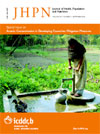
|
The Journal of Health, Population and Nutrition
icddr,b
ISSN: 1606-0997
EISSN: 1606-0997
Vol. 39, No. 1, 2020, pp. 1-15
|
 Bioline Code: hn20006
Bioline Code: hn20006
Full paper language: English
Document type: Research Article
Document available free of charge
|
|
|
The Journal of Health, Population and Nutrition, Vol. 39, No. 1, 2020, pp. 1-15
| en |
Complementary feeding practices and nutrient intakes of children aged 6–24 months from Bangladeshi background living in Tower Hamlets, East London: a feasibility study
Jabri, Laura; Rosenthal, Diana Margot; Benton, Lorna & Lakhanpaul, Monica
Abstract
Background: The aim of this study was to assess dietary intakes and complementary feeding practices of children
aged 6–24 months who are from Bangladeshi ancestry and living in Tower Hamlets, London, and determine the
feasibility of a larger, population-representative study.
Methods: Questionnaires for demographic variables and feeding practices, and 24-h dietary recalls were
administered to 25 mothers to determine whether it would be feasible to conduct a similar study on a
representative sample size of the same population. Data from both tools were used to determine adequacy of
complementary feeding practices through the WHO indicators and an infant and child feeding index score as well
as overall macronutrient and micronutrient intake.
Results: Four children had varying suboptimal complementary feeding practices: two children failed to achieve the
minimum dietary diversity, one child was being fed cow’s milk before the age of 1 year, and one scored ‘poor’ on
the infant and child feeding index. Most notably, the mean protein intake (39.7 g/day, SD 18.2) was higher than
RNIs for all age groups (P = 0.001). Vitamin D intake was below recommendations (P = 0.006) for the 12–24-month
age group. For the 10–12-month age group, zinc intake fell below recommendations (P = 0.028). For the 6–9-month
combined age group, iron and zinc intakes were below recommendations (P = 0.021 and P = 0.002, respectively).
Conclusions: Given the feasibility of this study, the results obtained require a large-scale study to be conducted to
confirm findings. Our initial results indicated that children from Bangladeshi heritage may not be meeting
nutritional requirements; thus, a future intervention tailored to the needs of the Bangladeshi population may be
required to improve aspects of complementary feeding practices and nutrient intakes of those children.
Keywords
Infant feeding; Complementary feeding practices; Bangladeshi; Nutrient intake
|
| |
© Copyright 2020 - The Author(s)
Alternative site location: http://www.jhpn.net
|
|
